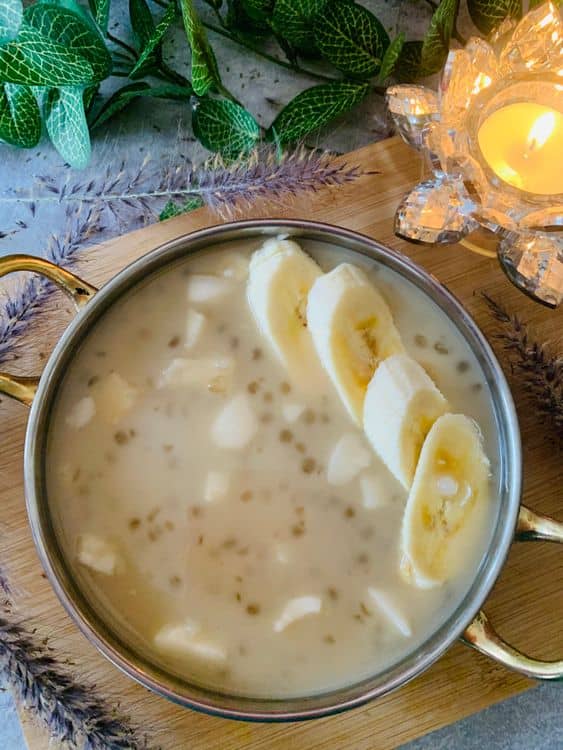Banana in Sago Cream, a dessert bursting with comforting flavours, is ideal for special occasions and festive celebrations.
This easy, creamy delight is created by cooking sago pearls (sabudana) in coconut milk and adding sweet banana slices for a delicious treat.
Enjoy every spoonful!

Stuck mid-recipe?
Chefadora AI has the answer - timers, swaps, step-by-step help.
Ingredients
- Sago Pearls (Sabudana)1cup
 Water (divided)2cup
Water (divided)2cup Sugar1/4cup
Sugar1/4cup Jaggery Powder1tbsp
Jaggery Powder1tbsp Coconut Milk2cup
Coconut Milk2cup- Rock Salt (Sendha Salt)1/4tsp
- Coconut (sliced/chunks)1/3cup
- Bananas (ripe)2
Nutrition (per serving)
Calories
342.5kcal (17.13%)
Protein
2.5g (5%)
Carbs
59.0g (21.45%)
Sugars
29.5g (59%)
Healthy Fat
1.5g
Unhealthy Fat
7.5g
% Daily Value based on a 2000 calorie diet
How to make Banana in Sago Cream
- Step 1
Thoroughly rinse the sago pearls in running water. Soak them in a cup of water for at least an hour or overnight to reduce cooking time. Drain any excess water.
- Step 2
In a small pot over medium heat, bring enough water to a boil to cover the sago pearls.
- Step 3
Add the sago pearls, stir gently, and cook for about 5-6 minutes or until they become translucent. Remove from heat, rinse well, and drain. Set them aside.
- Step 4
In a deep pot, combine 1 cup water, sugar and jaggery. Bring it to a boil over medium-high heat and simmer for 5 minutes, stirring occasionally.
- Step 5
Stir in the coconut milk and salt, and cook additional for 4-5 minutes while stirring.
- Step 6
Add the translucent sabudana and the sliced coconut to the simmering milk.
- Step 7
Cook on medium-high heat, stirring constantly until the milk reduces and reaches a slightly thick consistency. Avoid reducing the milk too much, as the kheer will thicken as it cools. Turn off the heat.
- Step 8
Allow the mixture to cool down to room temperature.
- Step 9
Peel the bananas and slice them thickly.
- Step 10
To serve, place a few slices of banana in each bowl and ladle the coconut milk and sabudana mixture over them.
- Step 11
Serve the kheer either warm or at room temperature.
- Step 12
Enjoy!
Nutrition (per serving)
Nutrition (per serving)
Calories
342.5kcal (17.13%)
Protein
2.5g (5%)
Carbs
59.0g (21.45%)
Sugars
29.5g (59%)
Healthy Fat
1.5g
Unhealthy Fat
7.5g
% Daily Value based on a 2000 calorie diet
Tips & Tricks
Soaking Sago pearls overnight reduces cooking time.
Use ripe bananas for the best flavour.
Adjust the sweetness to your liking.
If the kheer thickens too much, adjust by adding more coconut milk or regular milk.
You can the kheer chilled, it’s at its best when served warm.
This recipe yields 4-5 servings, depending on the portion size.
FAQS
How do I cook sago pearls for Banana in Sago Cream?
To cook sago pearls for Banana in Sago Cream, start by thoroughly rinsing them under running water. Soak the pearls in water for at least an hour or overnight to reduce cooking time. Then, boil enough water to cover the sago pearls, add them, and cook for about 5-6 minutes until they become translucent. Rinse and drain before adding them to the coconut milk mixture.
Can I make Banana in Sago Cream dairy-free?
Yes, Banana in Sago Cream can easily be made dairy-free by using coconut milk, which is already a key ingredient in the recipe. Ensure that all other ingredients, like sugar and jaggery, are also free from dairy products to maintain the dish's compatibility with a dairy-free diet.
What can I substitute for jaggery in Banana in Sago Cream?
If you don't have jaggery on hand, you can substitute it with brown sugar or coconut sugar in equal amounts. This will provide a similar sweetness and flavor profile, although the taste may vary slightly. Just remember to adjust the sweetness to your preference.
How should I store leftover Banana in Sago Cream?
To store leftover Banana in Sago Cream, place it in an airtight container and refrigerate. It can be kept for up to 2-3 days. When ready to serve, you can enjoy it cold or gently reheat it on the stove, adding a splash of coconut milk if it has thickened too much.
What are some good pairings for Banana in Sago Cream?
Banana in Sago Cream pairs wonderfully with a variety of accompaniments. You can serve it alongside fresh tropical fruits like mango or pineapple for a refreshing contrast. Additionally, a sprinkle of toasted nuts or seeds can add a delightful crunch and enhance the overall flavor of the dessert.
Leena Kohli
(@leenakohli)
Elevate your confidence through the magic of home cooking with my easy-to-follow recipes 👩🍳✨
Marnirni-apinthi Building, Lot Fourteen,
North Terrace, Adelaide, South Australia, 5000
Australia
